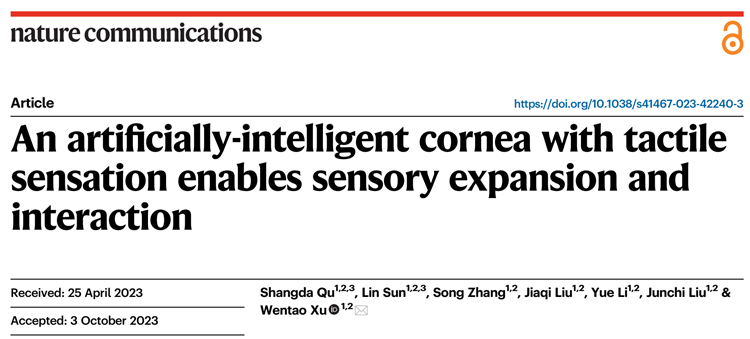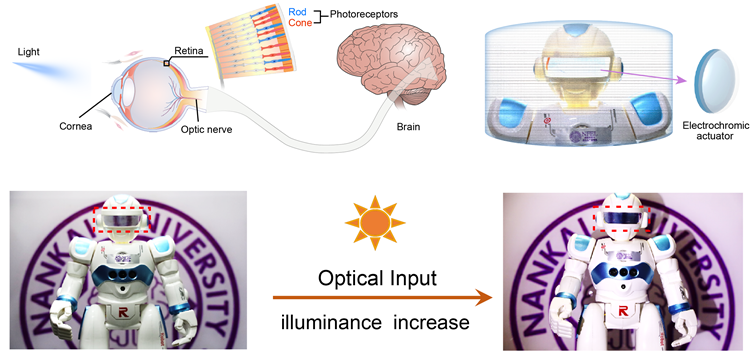Make Artificial Cornea “Blink” –NKU Team Proves the Concept of Artificial Intelligent Cornea with Tactile Sensation
Recently, the team led by Professor Xu Wentao from the College of Electronic Information and Optical Engineering of Nankai University designed and performed proof of concept on an artificial intelligent cornea with tactile sensation, bringing the artificial cornea one step closer to the human cornea.
In recent years, a range of artificial corneas, such as Boston-type cornea and MICOF-type cornea, have been applied to clinical treatment. These artificial corneas perform the functions of human cornea such as protection and light refraction, but lack tactile sensation and cannot realize corneal reflex. Accordingly, the development of artificial intelligent corneas with tactile sensation is important for addressing the shortage of corneal donors and curing corneal diseases.

The picture shows the reflex arcs of artificial corneal and native human corneal
The artificial intelligent cornea developed by Professor Xu Wentao’s team restores the “native sensation” through an artificial reflex arc. The team realized the encoding of external mechanical and optical stimuli, information processing, and regulation of transmission light using sensor oscillating circuit, zinc tin oxide (ZTO) fiber-based artificial synapses, and electrochromic devices as receptor, processing core, and effector, respectively. Using digitally-aligned ZTO fibers as channels of artificial synapses, the team developed a new method for tuning long and short-range synapse plasticity. ZTO fiber is long and continuous, eco-friendly and non-toxic, with low cost and excellent optical performance (transmittance > 99.89%, haze < 0.36%). Moreover, its crystal structure is precisely tunable, and the long- and short-range synaptic plasticity can be customized and applied to associative learning and encrypted communication.

The research findings were recently published in Nature Communications, a world-renowned academic journal. Qu Shangda, a doctoral candidate at the School of Electronic Information and Optical Engineering of Nankai University, and Sun Lin, a postdoctoral fellow, are the first authors of the paper, and Professor Xu Wentao is the corresponding author.

The picture shows the research team equipping a robot with an artificial intelligent cornea to demonstrate proof of concept
Professor Xu Wentao introduced that the team had equipped the robot with artificial intelligent cornea for proof of concept, which can imitate the contraction of the orbicularis oculi muscle, fulfilling the functions of protection, tactile perception and light refraction as a native human cornea does. It also enhances the capacity for light perception and environmental interaction, providing extra adaptive protection for the eye in an environment with changing light intensity, making it more intelligent than the traditional artificial cornea.
“The optimized mature artificial intelligent cornea will have broad application prospects in nerve repair and visual rehabilitation,” Professor Xu Wentao said.
Link to the paper: https://doi.org/10.1038/s41467-023-42240-3
(Edited and translated by Nankai News Team.)









